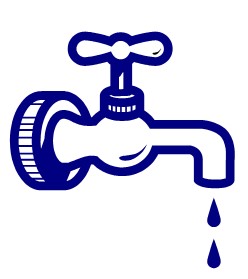Bolivar WSC requires that ALL existing and future automatic irrigation systems served by BWSC be equipped with an RPZ Backflow Preventer located at the point of entry from customer service line to irrigation system
Common Questions about the Cross Connection Control and Backflow Prevention Program
Q. What is backflow?
A. Backflow refers to the reverse flow of non-potable water, or other substances, through a cross-connection and into the piping of a public water system or customer's potable water system. Two types of backflow are backpressure backflow and back-siphonage.
Q. What is a cross-connection?
A. A cross-connection is any temporary or permanent connection between a public water system and any source or system containing non-potable water.
- Common cross-connections:
- Private wells – where the private well connection is connected to a service line receiving water from a public water supply. The untreated water could be pumped into the potable water supply which serves the home and the public water system.
- Lawn sprinkler systems – where the stagnant/contaminated water from the sprinkler system could be drawn into the drinkable water supply for your home.
Q. Why do water suppliers need to control cross-connections and protect their public water systems against backflow?
A. Backflow into a public water system can pollute or contaminate the water in that system. Water suppliers must take precautions to protect its public water system against backflow. The Cross-Connection Control and Backflow Prevention program safeguards the public drinking water and protects the health of its customer by ensuring that any contaminants that could backflow into the public water supply system are isolated within the customer’s internal distribution system.
Q. What is the most common form of cross-connection?
A. The ordinary garden hose is used to create the most common form of cross-connection. A hose can be easily connected to the drinking water supply and used for a variety of potentially dangerous applications.
Q. What is back-siphonage?
A. Back-siphonage is backflow caused by negative pressure (i.e. vacuum or partial vacuum) in a public water system or customer's potable water system. The effect is similar to drinking water through a straw. Back-siphonage can occur when there is a stoppage of water supply due to nearby fire-fighting, a break in a water main, among other reasons.
Q. What is back-pressure?
A. Back-pressure occurs when the water pressure in a customer’s plumbing system exceeds the pressure of the water distribution system supplying the water. This backpressure might be caused by a difference in elevation, by a pump in a steam boiler, or by other means.
Q. Does a lawn irrigation system require a backflow prevention assembly?
A. Yes. Section 312.10.1 of the Plumbing Code, connections to lawn irrigation systems, states that the potable water supply to lawn irrigation systems shall be protected against backflow and potential hazards. In TCEQ RG-470 Revised July 2015, on page 39 the irrigation code, 344.51(d)(2), states that any connections using a private or public potable water source must be connected to the water source through a reduced pressure principle backflow prevention assembly as defined in 344.50 of this title (relating to Backflow Prevention Methods). This means that if you have a lawn irrigation system and have a septic system, you need an RPZ backflow prevention assembly for your irrigation system. The septic system increased the level of hazard to require this.
Q. What is a backflow preventer?
A. A backflow prevention device or assembly is mechanism to prevent backflow. The basic means for preventing backflow is an air gap, which either eliminates a cross connection or provides barrier from backflow. The basic mechanism for preventing backflow is a mechanical backflow preventer, which provides a physical barrier to backflow.
Q. Why do backflow prevention assemblies need to be tested?
A. Mechanical backflow prevention assemblies have internal seals, springs, and moving parts that are subject to fouling, wear or fatigue. Also, mechanical backflow preventers and air gaps can be bypassed. Therefore, all backflow prevention assemblies have to be tested periodically to ensure that they are functioning correctly. Mechanical backflow prevention assemblies have to be tested with properly calibrated gauge equipment.
Q. How often does the backflow prevention assembly need to be tested?
A. Backflow prevention devices must be tested and certified upon installation and at least once every year. The test and certification must be done by a licensed backflow tester.
Q. Is Bolivar WSC the only water provider enforcing backflow regulations?
A. No, all public water systems are required to implement cross-connection control programs in the State of Texas.
Q. I have had a double check on my irrigation system for years and I also have a septic system for my house. Why is a double check valve not acceptable now?
A. If your irrigation system was installed after 2009, your irrigation system installer should have installed an Reduced Pressure Zone Assembly (RPZ), not a double check valve. If they installed a double check valve, they were not following the irrigation code for the State of Texas. TCEQ requires that all properties that have an irrigation system and an On-Site Sewage Facility transition over to RPZ’s. The irrigation code and plumbing code has created a phased in approach to accomplish this. If you have ANY repairs made to your irrigation system, your plumber or licensed irrigator is required to install an RPZ BEFORE they repair your system. This is to help get everyone transitioned over to the appropriate backflow device given the potential hazard created by the septic system.

